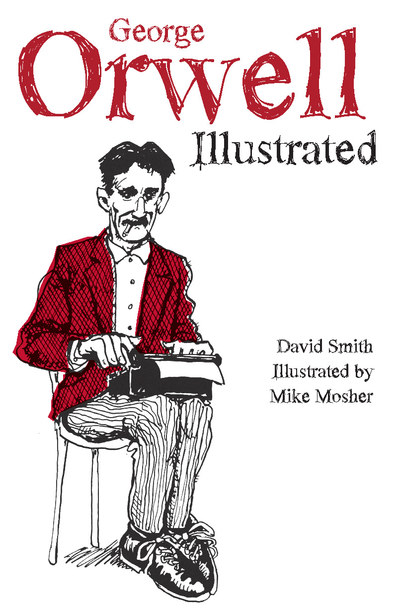 Reviewed: George Orwell Illustrated, written by David Smith, illustrated by Mike Mosher. Haymarket Books, 2018.
Reviewed: George Orwell Illustrated, written by David Smith, illustrated by Mike Mosher. Haymarket Books, 2018.
I. Well-Meaning Literary Men
Under the Nazi regime, the Gestapo was rumored to employ scholars who would analyze the prose style of anonymous pamphlets and thereby identify the authors. “[If ] only it were in a better cause,” Orwell once confessed, “this is exactly the job I would like to have.”
No literary critic working for the secret police would have trouble identifying the principal author of the manifesto, published for the first time in George Orwell Illustrated, calling for the creation of an international democratic-socialist human rights organization. Written by George Orwell, with additions and revisions by Arthur Koestler and Bertrand Russell, the manifesto begins by seeking to expand “the Nineteenth Century conception of liberty and democracy” to include “equality of opportunity and a reasonable degree of equality of income,” while also faulting the Left for its “contempt for democratic traditions” like “habeas corpus, freedom of speech and of the press, the right to political opposition and absence of political terrorism.” After a few specific examples, it argues that “the gradual decay of democratic sentiment, of human decency, and the desire for liberty” may have real political consequences, since it practically guarantees that “resistance . . . would be much weaker” should one of the Western democracies face foreign aggression or the rise of a homegrown authoritarian regime. As a guard against such eventualities, the document advocates the creation of a non-partisan, non-sectarian, and international organization that would defend the established democratic rights, against no matter what threat, while also fighting to expand the concept of democracy to include “a synthesis” combining “political freedom on the one hand and economic planning and control on the other.”
This untitled manifesto, while nominally a collaboration, is quintessential Orwell. Not only the clarity of expression and the humanity of its perspective, but even its particular examples and turns of phrase all echo his other work. Though the specific sentences are not lifted verbatim from Orwell’s essays, they are so close in logic, diction, and syntax that they sound as though they were direct copies. What is original in this document is that effort to convert his values and principles into a practical political program, and what comes across more clearly here than anywhere else in Orwell’s work is the notion that democracy and socialism are not merely two desirable and complementary ideals, but are, or ought to be, the same thing — that socialism is simply the extension of democratic principles into the economic life of the society and that, in fact, without such an extension, democracy is an empty phrase of no real benefit to the majority in whose name it is established.
Nothing came of the proposed League, but then, as Orwell said elsewhere, “nothing advocated by well-meaning literary men ever happens.”
II. Comic Art for Tragic Times
The Orwell-Koestler-Russell manifesto, long lost and practically forgotten, is the single most valuable contribution of George Orwell Illustrated.
The bulk of the volume reprints Orwell for Beginners, originally published (of course) in 1984. It is a serviceable introduction to Orwell’s life and work, both concise and comprehensive, but not on its own a marked advance in the scholarship. As a study it marches dutifully through the major events of Orwell’s life — Eton, Burma, struggling novelist, Spain, Home Guard, BBC, tuberculosis — and through his major works, from Down and Out in Paris and London to Animal Farm and Nineteen Eighty-Four. Being “for beginners,” a great deal of space is given over to tedious plot summaries and general commentary, but on the whole it is competently handled and refreshingly free of the petty partisanship that spoils so much of the scholarship on Orwell.
“Planet Orwell” — the section comprising the new material in the book; the last seventy of roughly 270 pages — considers Orwell’s thought in a variety of contexts, from Stalin’s show trials to Trump’s reality-television presidency. The centerpiece, of course, is the newly discovered manifesto. But this section also covers the attempts to conscript Orwell to the Cold War, and the renewed interest in his work in the age of NSA eavesdropping and “alternative facts.” Of the two major sections, “Planet Orwell” is the more interesting and original. Readers who are not “beginners” may profit by familiarizing themselves with its content.
Unfortunately, the weakest element of this volume is precisely what should be the distinguishing feature of a book titled George Orwell Illustrated — the illustrations. Bringing together pen-and-ink drawings of various types — straight illustration, caricature, and comic strips — along with photographs, photomontage, and (usually uncredited) archival images, the resulting assortment nevertheless adds little if anything of substance to the text and the artwork is rarely interesting enough to justify itself as pure decoration. The idea of an illustrated volume is of course a very good one, but the opportunity here has been wasted. Fewer but better illustrations, more carefully conceived and executed, would have been preferable. As it stands, the collection of largely indifferent doodles, surrounding the occasional humorous gem (Stalin as Hamlet, for example), are not even so remarkable as to spoil an otherwise satisfactory book, though they may leave more philistine readers convinced that cartooning is necessarily synonymous with mediocrity.
Kristian Williams is the author of Between the Bullet and the Lie: Essays on Orwell (AK Press, 2017).
